Slopes Diaries #19: App Store Review Replies
Slopes Diaries is my ongoing journey to turn my indie app into a more sustainable part of my business. First time reading? Catch up on the journey so far.
What is Slopes? Think Nike+, Runkeeper, Strava, MapMyRun, etc for skiers and snowboarders.
Apple gave us indies a great new opportunity yesterday: the ability to break the silence with customers.
Since the App Store launched, many customers have felt abandoned by developers. They could leave a review asking for some kind of fix / improvement, but then they'd just have to sit back and wait hoping the feedback was heard. Often it wasn't, many developers ignored the reviews all together (if you didn't put in the effort to encourage reviews from all users, the review section could often feel like a demoralizing catch-all for negative feedback). But even when they were read, there was no immediate "we heard you!" feedback, and that stung.
Or, worse, the silence was maddening to us developers. Customers would leave an inaccurate review and no amount of screaming "you can do that, just tap here!" at our monitor could help that poor soul.
We'd add "contact support" links on our about screen, and the savvy customers would use them, but honestly we can't expect all users to follow our preferred help solution. We can point them there, but we can't ignore users that start elsewhere.
@parrots @reneritchie I used to say this about Twitter. We need to engage the customer where they are, not where we would like them.
— Jean MacDonald (@macgenie) January 24, 2017
Fortunately now we can engage them where they are. This is an awesome opportunity to turn a few things around on the App Store, and I hope every indie aggressively pursues this. With this we can start to shed the idea of "faceless developer." I've been trying to tackle this issue myself with Slopes by being very responsive and personal with people who reached out to me via email or social media, but now I can do it publicly in the App Store too.
This great power does come with responsibility though. Realtalk: we all feel the need to be "right" often. Especially when it comes to defending work we pour or souls into. I know I do. I want to warn you: the new reply capability is not the place for that. You need to check your "but someone on the internet is wrong!" really hard here. You will not convince people your app's price is worth it via these replies, and in the mean time everyone checking out your app will see you arguing with customers.
To phrase it another way: these are as much replies to existing customers as they are PR statements to future ones.
With that in mind, I did a pass through my ~700 or so reviews yesterday with the following goals:
Educate the customer leaving the review about a feature they missed, which educates future customers browsing the store that Slopes can do X, Y, or Z.
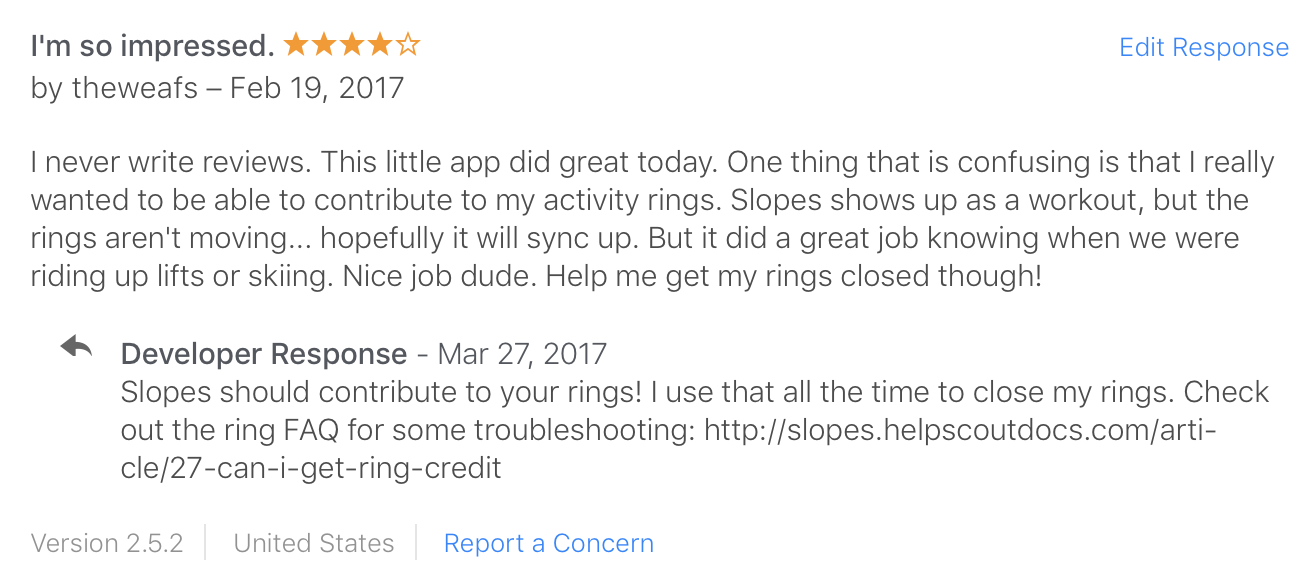
(man I wish links were tappable. Please dupe radar 31289102 if you agree.)
Acknowledge potential flaws. The customer is frustrated, because somehow either your code or an Apple SDK failed them. Helping them shows future users you are proactively reaching out. This is great PR.
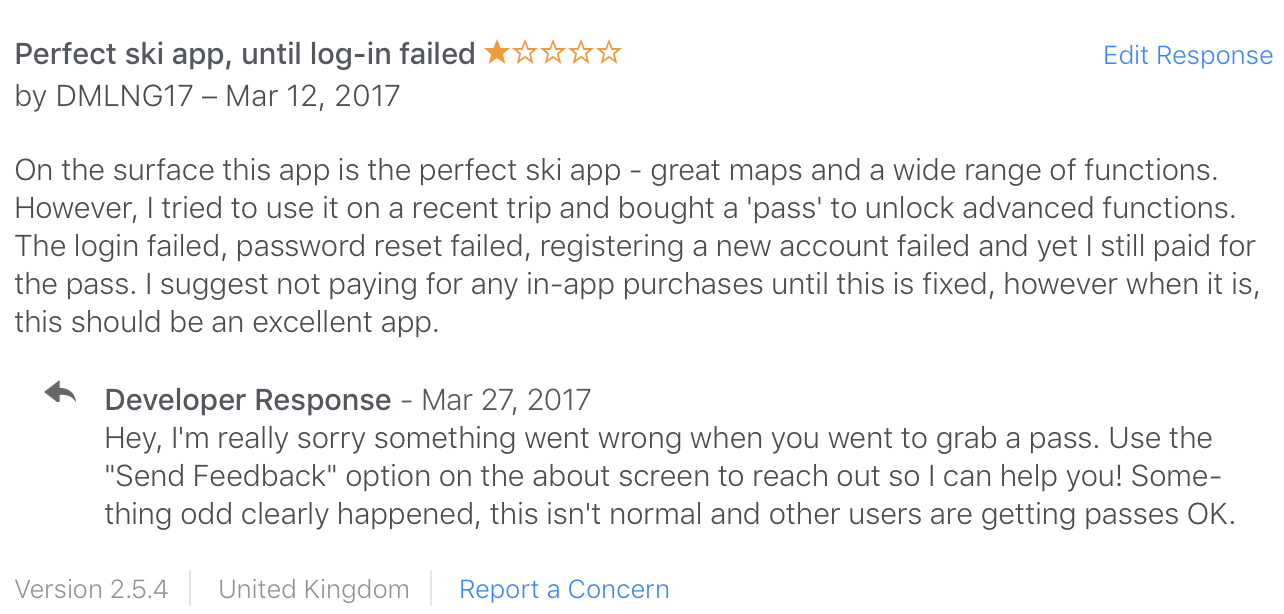
Demonstrate that you listen and change. For example my prices in Europe were likely a bit too high, so I adjusted my Season Pass price a bit ago. In each European App Store I found a recent review complaining about price and replied to show I'm listening.
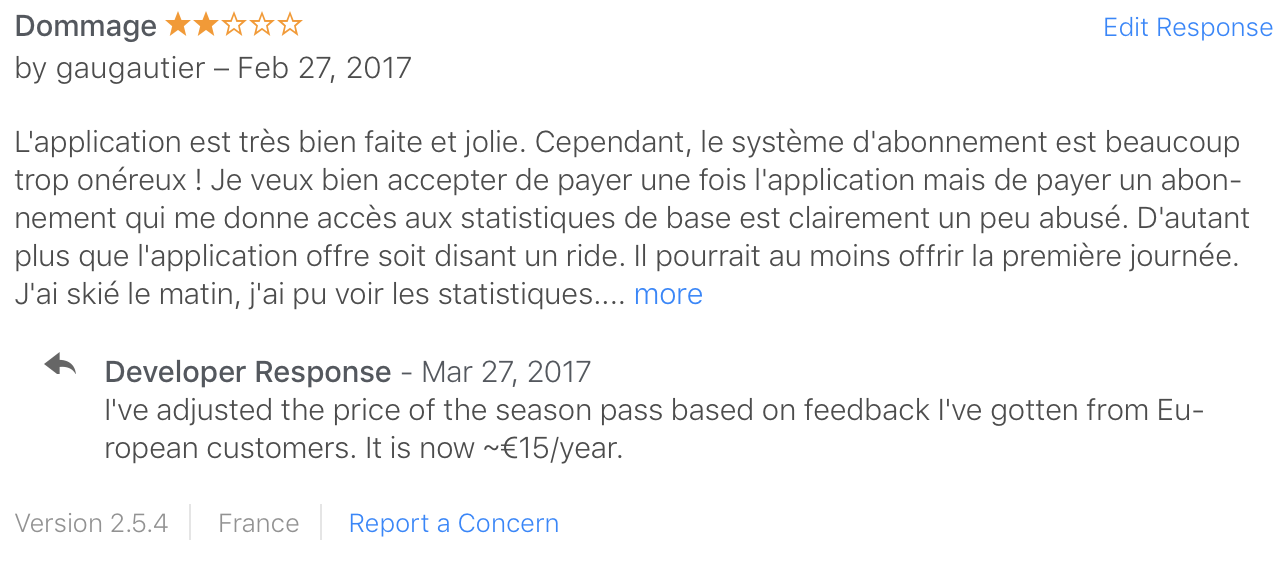
Don't pick a fight. This review had me annoyed for a long time, it was basically an ad for a competitor over a minor UX choice I made. And the title was very misleading. Instead of arguing about how his title is technically wrong, I used the opportunity to turn it around and show I've got their complaint covered and I'm respecting a whole class of users that often feel neglected.
I didn't mention price, once.
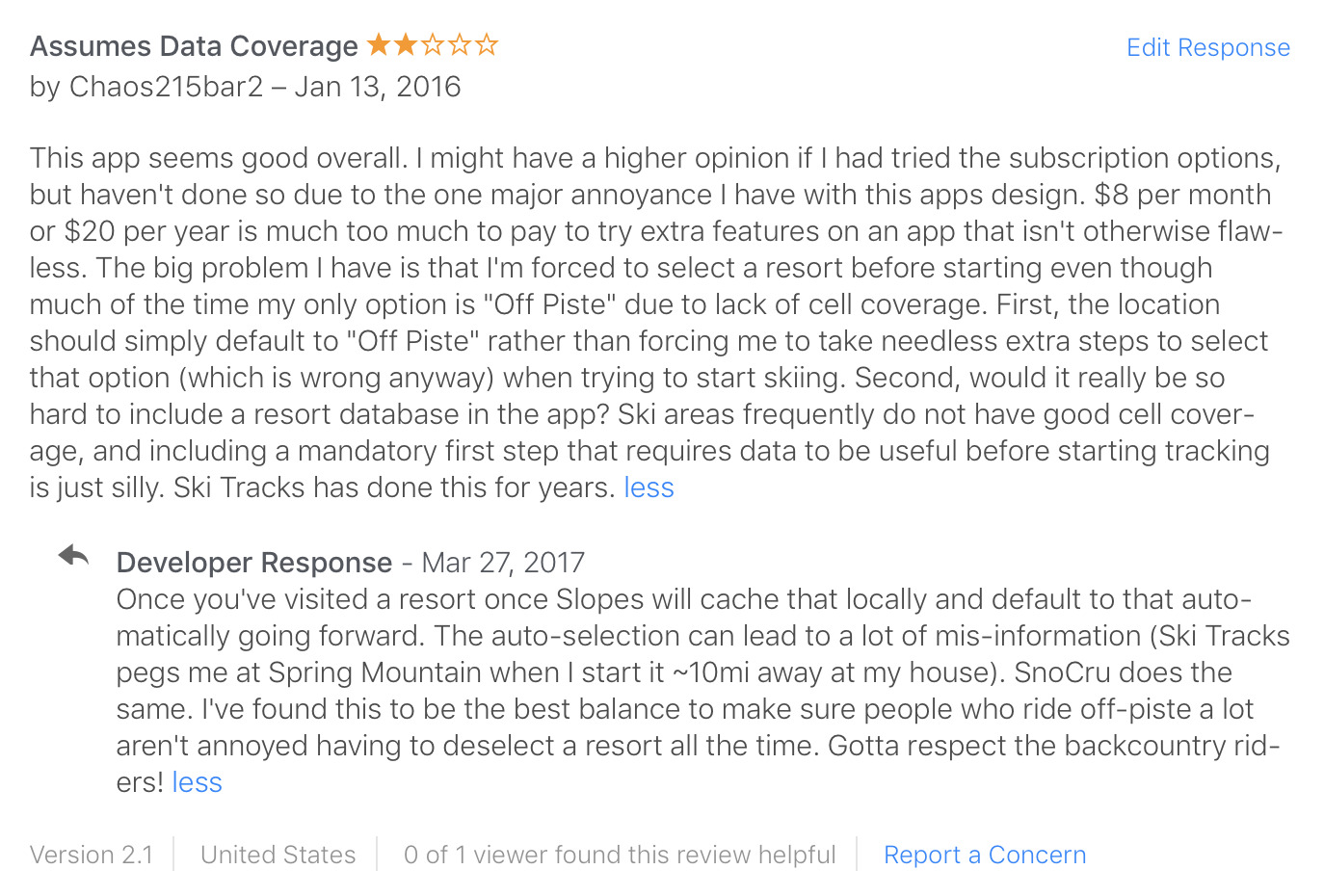
And, lastly have fun. This is more part of my brand, but I like to keep my PR lightweight when I can. I wanted to make sure to drop some of that into my responses so future customers can get a feel for that.
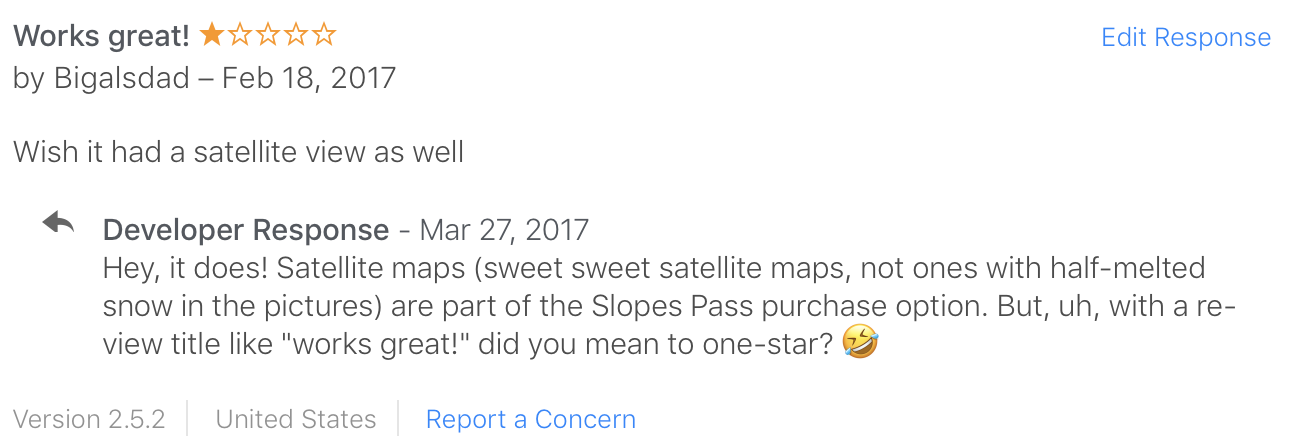
Responding to reviews with these goals in mind helped my existing customers, sure, but those goals where specifically formatted to make sure the message I was publicly broadcasting was a positive one that I feel other customers will appreciate.
Engage Today
I'd recommend every app owner do the following, today. Head into the review section in iTunes Connect and sort by "Most Helpful." These are reviews that customers have voted should be floated to the top, and that's what Apple does. Take a quick look through there and see which ones you can address.
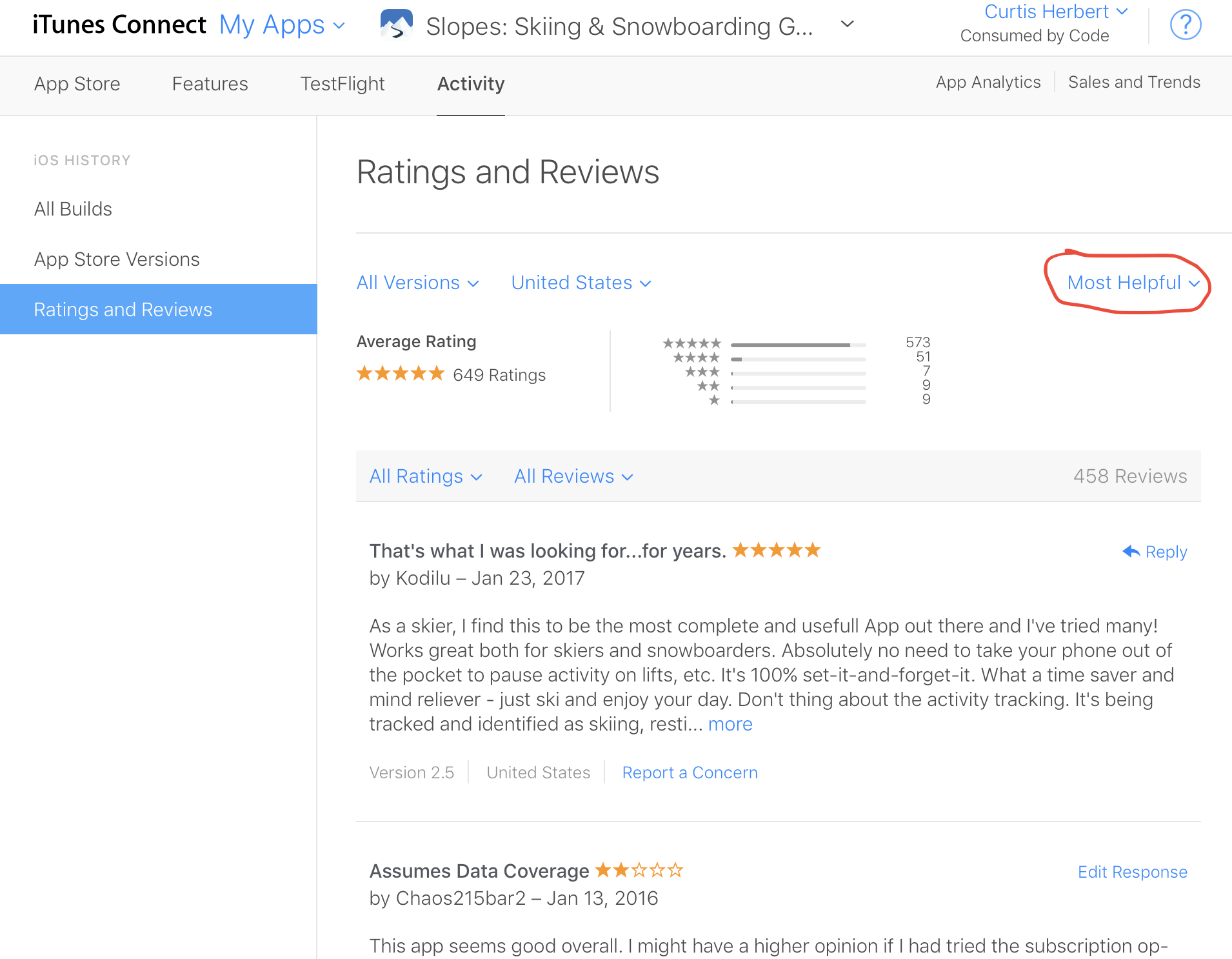
Future customers are most likely to see your replies to these reviews, so that's the best bang-for-the-buck you can do right now. I went further than that, personally, and re-read a ton of my negative reviews and replied to the ones that met the above goals, but you don't have to rush it.
While you're doing it avoid the urge to say "please email help@myapp.com!" to everything. If you can, help them there in iTC. A wall of "please email!" replies will look just as bad as no replies. I'm even reconsidering how I point users to my existing FAQ since links don't work -- might be best to copy/paste the content. I'm sure we'll have some best-practices emerging soon, but after a day with the system I think my rule is "help them in iTC as much as I can, or give them a simple email address they can type."
Listen to the actual customer support professionals. They've been dealing with public-facing customer support for a long time before us, and we have a lot to learn. I saw Sarah Hatter from CoSupport speak at Release Notes last year and her book has been on my to read list of a while. I think it is time to get to doing that. I'm OK fumbling my replies when they are private, but I think we could all do to learn how to be a bit better now that things are so public.
In the end I think this new ability be a win for us, and I'm aggressively all-in on 'em. Developer replies stand out when scrolling through reviews on iOS. People will notice our efforts, and it is one of the few ways we can really stand out in the App Store.